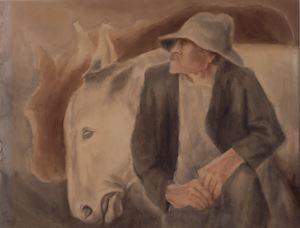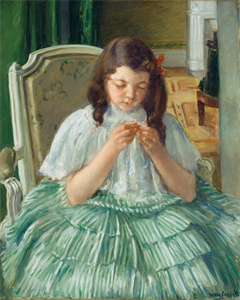
Crawford Gillis
American, 1914–2000
This watercolor is typical of Gillis’s aesthetic and his subjects. He consistently painted the rural population, in this case most likely a poor tenant farmer with the mules that were used to work the fields. The layered composition of the man superimposed over the mules was influenced by the work of the Mexican muralists, whose style was emulated by American artists working under the auspices of the federal relief programs. Although Gillis was not employed in these programs, he was aware of the general trend at this time toward regionally specific subject matter. The umber tonality also mimics the practice of the mural painters, who tended to restrict their palettes in order to focus attention on design. Gillis painted the locale, but he never considered himself a Regionalist. “I thought it [the Regionalist style] was a superficial view,” he said. “I believed that the native landscape could be depicted to have universal meaning.”
American, 1914–2000
Untitled (Man with Two Mules in Profile)
about 1938
Object Type:
Painting
Dimensions:
19 1/2 in. x 24 5/8 in. (49.53 cm x 62.55 cm)
Medium and Support:
Watercolor on paper
Accession Number:
1993.0008
Credit Line:
Gift of Sally Knight in memory of Paul and Mattie Mae Sanderson
This watercolor is typical of Gillis’s aesthetic and his subjects. He consistently painted the rural population, in this case most likely a poor tenant farmer with the mules that were used to work the fields. The layered composition of the man superimposed over the mules was influenced by the work of the Mexican muralists, whose style was emulated by American artists working under the auspices of the federal relief programs. Although Gillis was not employed in these programs, he was aware of the general trend at this time toward regionally specific subject matter. The umber tonality also mimics the practice of the mural painters, who tended to restrict their palettes in order to focus attention on design. Gillis painted the locale, but he never considered himself a Regionalist. “I thought it [the Regionalist style] was a superficial view,” he said. “I believed that the native landscape could be depicted to have universal meaning.”
Keywords
Click a term to view the records with the same keyword
Portfolio List
Click a portfolio name to view all the objects in that portfolio
This object is a member of the following portfolios:
Your current search criteria is: Portfolio is "Classification: Painting" and [Object]Century is "Twentieth century".

 by Artist (156)
by Artist (156)
